Featured Golf News
Irish Journey Concludes at Ballybunion, Waterville & Old Head
[Editor's Note: This is fourth and final installment of an Irish golf adventure taken by Cybergolf contributor, Rob Duca. Visit Rob's section in Writers Corner - http://www.cybergolf.com/writerscorner - for his first three stories on his Emerald Isle travelogue.
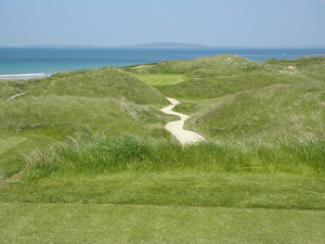
The 13th Hole at Ballybunion
Ballybunion has been my favorite course in the world since I first visited it in 1989. I have a number of reasons for being smitten by this Irish jewel. It's a classic seaside-links layout carved out of rolling hills, with endless ocean views of the Shannon Estuary and high grass covering sand dunes that rise and fall throughout the course. Even better, you can see the entire 18 holes laid out before your eyes from the elevated tees.
Virtually treeless, Ballybunion is characterized by dramatic contours from fairways to greens, and requires accurate irons and delicate pitch shots that might dart any which way. Add howling wind and you've got a daunting challenge.
I'm not certain how I initially became aware of the course, other than to remember someone once telling me that if I went to Ireland I must play Ballybunion.
So I showed up one weekday morning 24 years ago hoping to play, although without a tee time. In those days, one could get away with such naiveté. I casually mentioned that I was a golf writer from the United States and, before I realized what was happening, the starter was whisking us through a crowd, shouting, ''Please step aside, American press, American press!''
We were ushered directly to the first tee.
''Go ahead and hit,'' he said, standing a foot or so away.
I looked at him with a mixture of shock and fear. I looked at the angry faces surrounding the tee, most of whom had booked their rounds months in advance. I peered out at the graveyard that lurked to the right of the fairway. And then I stared down at my golf ball, which appeared utterly lonely and impossible to hit.
Then we were off on an unforgettable experience, walking up and down hills, playing shots from deep valleys surrounded by grassy dunes and from majestic vantage points where we could almost feel the ocean's spray.
Ballybunion has seemingly been around forever, but it actually opened for play in the late 19th century. Yet it did not become a tourist destination until the early 1980s when Tom Watson called it his favorite European course.
''After playing Ballybunion for the first time, a man would think that the game of golf originated here,'' Watson wrote. ''There appears to be no manmade influence. It looks like a course laid out on land as it was back in the 10th century.''
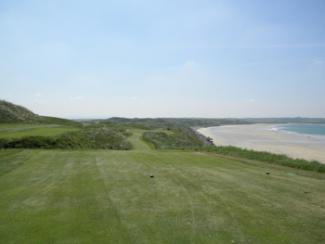
No. 16 at Ballybunion
As you would expect, those words from a five-time British Open champion carried considerable weight, and Watson's proclamation is still displayed with great fanfare at the club.
Other PGA pros soon discovered Ballybunion. By the late-1990s, many were traveling across the Pond for the British Open one week early so they could slip in a round at Ballybunion. Tiger Woods fell in love with the course's history and allure. President Bill Clinton also made a pilgrimage.
Much has changed since I first visited. Tee times must now be made months in advance, even for the American press. But at its core, Ballybunion remains ever-magnificent and mystical. Even if your opening tee shot should wind up in the graveyard.
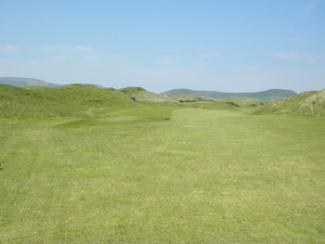
The 11th at Waterville
Waterville
For a course to follow Ballybunion is like being next on the bill after The Beatles. Waterville Golf Club was next on our itinerary, and it paled in comparison.
The course in County Kerry has undergone many reincarnations through the years. The original century-old links were abandoned in the 1950s until an Irish-born American, John A. Mulcahy, joined forces with Irish architect Eddie Hackett and former Masters champion Claude Harmon to design a new 18-hole layout in the 1960s. The new course opened in 1973 and has since played host to numerous professional tournaments. It was sold in 1987 to a group of Irish-Americans and, today, remains a popular golfing destination, thanks in part to a recently completed Tom Fazio remodel.
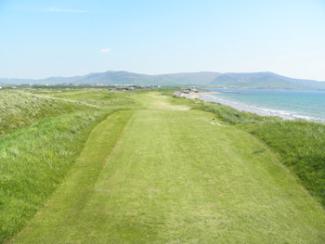
Waterville's Lengthy Closing Hole
The venue offers magnificent views of the ocean, the mountains and the surrounding countryside, and Waterville certainly has its share of memorable holes. The opening seven feature rolling terrain, with hard fairways and crowned greens that require graceful pitches. The 16th is framed by the mountains and ocean, while the ninth is a brutally difficult dogleg-right to a severely elevated green with steep bunkers to the right and left.
But the 12th hole is its most famous. The 200-yard par-3 is called the "Mass hole" because it plays over a hollow where locals secretly said Mass in the 17th century. Under the rule of Oliver Cromwell, the penalty if caught was death. The dramatic hole is surrounded by mounds and sand dunes, with the green sitting in a valley.
Waterville's closing hole is dazzling. The beach runs along the entire right side of the 594-yard par-5 as golfers head toward the clubhouse. Bunkers guard the left side of the fairway and encircle the green.
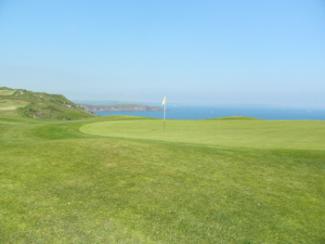
No. 3 at Old Head
Old Head
And then we traveled to Old Head Golf Links in Kinsale. The long, winding uphill drive provides little clue of what lies ahead until the final 150 yards. At that point, you reach the crest of a hill and the ocean unfolds before you.
Visually striking does not begin to describe this astounding course, which sits perched atop a towering precipice overlooking the Atlantic Ocean. Greens and fairways back up against 300-foot-high cliffs, and you feel as though you're playing golf at the edge of the world.
"Is there anywhere else you'd rather be," said my playing partner as he surveyed his surroundings on the majestic 12th hole, where you must hit a drive over a cliff to a blind fairway, with the ocean on the left providing perhaps the most remarkable scenery of any course I've ever played. There are panoramic ocean views on every hole, along with dramatic escarpments that, in some cases, are just a few knee-knocking feet from the edge of the fairway. I feel confident in saying you will never encounter a more eye-popping golf course.
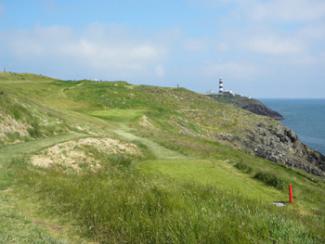
Old Head's Lighthouse Provides
Background on the 16th Hole
The green complexes were designed so that each offers an ocean view. The dogleg-left par-4 second plays toward a lighthouse built in 1853, with the ocean on the left and the green set hard against the cliff. The par-3 third is even more remarkable, with the cliff again running along the left side. The fourth is called "Razor's Edge" for good reason. It is the third straight hole that runs parallel to the ocean-side cliffs, with the lighthouse standing tall in the distance.
It is a breathtaking stretch of gorgeous holes. And it doesn't cease until you putt out on the No. 18, by which point you might feel overwhelmed by what you've just seen.
Afterward, we sat on the outside deck overlooking the course, with the Atlantic Ocean glistening in the distance, the sun shining upon us for the 10th straight day, sipping a perfectly poured Guinness.
And we thought, this is living.
Rob Duca is an award-winning sports columnist who wrote for the Cape Cod Times for 25 years, covering golf, the Boston Red Sox, the Boston Celtics and the Boston Bruins. He is now managing editor of Golf & Leisure Cape Cod magazine and has written for a variety of other publications, including Sports Illustrated, the Boston Globe, Yankee magazine and Cape Cod Life.
Story Options
 |
Print this Story |
